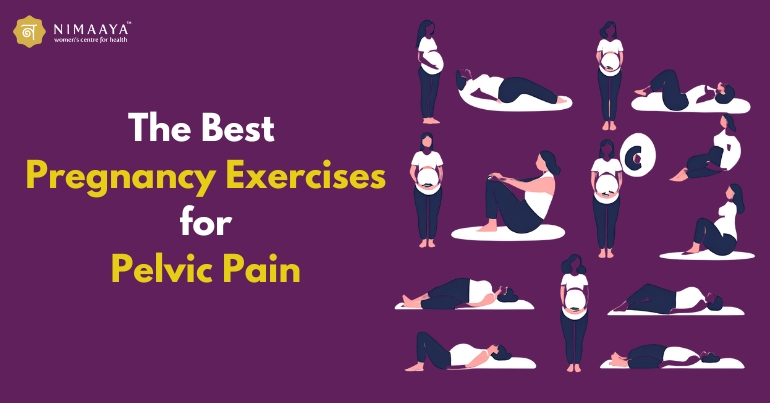Introduction
Pregnancy-related pelvic pain is something that most women suffer from due to hormonal imbalances, weight gain, and postural changes. These conditions often arise from symphysis pubis dysfunction (SPD) or pelvic girdle pain (PGP). However, safe pregnancy exercises can strengthen the muscles around the pelvis, stabilize them, and relieve pain.
This guide will cover:
- Causes of pelvic pain during pregnancy
- How exercises can help on this present occasion
- Safe and effective exercises
- Tips for managing the pain
Causes of Pelvic Pain During Pregnancy
Pelvic pain during pregnancy is primarily caused by hormonal and biomechanical changes, such as:
- Hormonal Changes: The relaxin hormone during pregnancy loosens ligaments and joints in preparation for childbirth, leading to instability and discomfort.
- Weight Gain and Postural Changes: The growing fetus shifts the center of gravity, increasing stress on the pelvic joints and lower back.
- Pelvic Girdle Pain (PGP) and Symphysis Pubis Dysfunction (SPD): These conditions cause the pelvic joints to become misaligned or excessively loose, leading to significant pain.
- Weak Core Muscles: A weakened core and pelvic muscles contribute to added strain on the lower back and pelvis.
Benefits of Exercise for Pelvic Pain
Regular pregnancy-safe exercises provide numerous benefits:
- Strengthening core, hip, and pelvic muscles
- Improving posture and balance
- Enhancing blood circulation during pregnancy
- Reducing pressure on pelvic joints
- Boosting overall well-being and mental health
Safe and Effective Exercises for Pelvic Pain During Pregnancy
While these exercises are generally safe, always consult a pregnancy physiotherapist or healthcare provider before beginning any new routine.
1. Pelvic Tilts
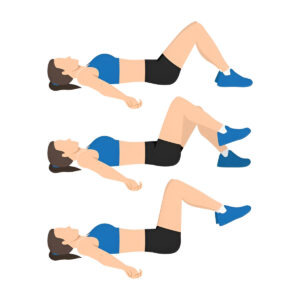
Purpose: Strengthens core muscles and reduces lower back and pelvic pain.
How to Do It:
- Lie on your back with knees bent and feet flat on the floor.
- Tighten abdominal muscles and flatten your back against the floor.
- Hold for 5-10 seconds, then relax.
- Repeat 10–15 times.
Modification: Perform on all fours to reduce spinal pressure.
2. Kegels (Pelvic Floor Exercises)
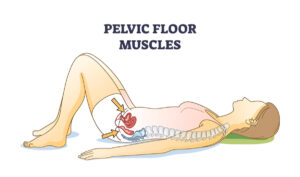
Purpose: Strengthens the pelvic floor muscles, supporting the uterus, bladder, and bowels.
How to Do It:
- Sit or lie in a comfortable position.
- Tighten the pelvic floor muscles as if stopping urine flow.
- Hold for 5-10 seconds, then relax.
- Repeat 10-15 times, three times a day.
Tip: Avoid holding your breath.
3. Bridge Exercise

Purpose: Strengthens gluteal muscles, lower back, and pelvic muscles.
How to Do It:
- Lie on your back with knees bent and feet hip-width apart.
- Slowly lift your hips towards the ceiling, keeping feet and shoulders on the floor.
- Hold for 5-10 seconds, then lower back down.
- Repeat 10-12 times.
Modification: Place a pillow under your lower back for extra support.
4. Cat-Cow Stretch

Purpose: Improves spinal flexibility and relieves pelvic and lower back tightness.
How to Do It:
- Get on all fours, hands under shoulders, knees under hips.
- Inhale, arch your back, and lift your head (Cow Pose).
- Exhale, round your spine, and tuck your chin (Cat Pose).
- Repeat 10-15 times.
5. Lateral Leg Lifts
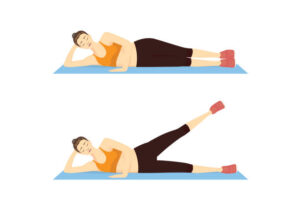
Purpose: Strengthens pelvic and hip muscles, improving stability.
How to Do It:
- Lie on your side with legs straight.
- Keep the lower leg slightly bent and lift the top leg towards the ceiling.
- Lower it slowly without touching the lower leg.
- Do 10-12 repetitions on each side.
Modification: Use resistance bands for added strength.
6. Deep Squats
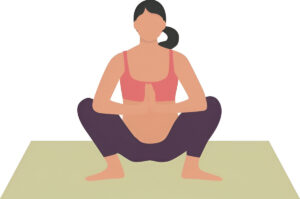
Purpose: Strengthens the pelvic floor and lower body muscles, increasing hip flexibility.
How to Do It:
- Stand with feet hip-width apart.
- Lower yourself into a deep squat, keeping knees aligned with toes.
- Hold for 10-15 seconds, then rise.
- Repeat 8-10 times.
Modification: Use a chair for support.
7. Seated Hip Stretch
Purpose: Relieves hip and pelvic tension.
How to Do It:
- Sit on a chair with feet flat.
- Place right ankle over the left knee.
- Lean forward slightly to stretch the hip area.
- Hold for 20-30 seconds, then switch sides.
8. Standing Pelvic Sway
Purpose: Increases pelvic flexibility and relieves tension.
How to Do It:
- Stand with feet hip-width apart.
- Slowly sway your hips in a circular motion.
- Continue for 30 seconds, then reverse direction.
9. Butterfly Stretch (Tailor Sitting)
Purpose: Enhances hip flexibility and strengthens inner thigh muscles.
How to Do It:
- Sit on the floor with soles of feet together.
- Gently press knees downward with elbows.
- Hold for 20-30 seconds.
10. Prenatal Yoga and Swimming
- Prenatal Yoga Poses for Pelvic Pain: Child’s Pose, Pigeon Pose, and Warrior Pose strengthen pelvic muscles.
- Swimming for Pregnancy Pain Relief: Water reduces joint pressure while offering low-impact resistance training.
Tips for Managing Pelvic Pain During Pregnancy
- Maintain Good Posture
- Wear Supportive Footwear
- Sleep with a Pregnancy Pillow
- Use Heat or Cold Therapy
- Consider a Maternity Belt
- Listen to Your Body
Read More: The Ultimate Guide to Antenatal Exercises
FAQs
Q: Is pelvic pain normal during pregnancy?
Yes, mild to moderate pelvic pain is common due to hormonal changes and weight gain. However, severe pain should be evaluated by a doctor.
Q: Would exercise that targets pelvic pain be safe in pregnancy?
Yes, provided they are being done correctly and under medical supervision. Gentle low-impact exercises such as pelvic tilts, Kegels, and prenatal yoga can help alleviate discomfort.
Q: When should I start exercising for pelvic pain?
You can start as soon as you resume discomfort, ideally even before if a preventive measure is desired, early in pregnancy. Consult your physician before beginning any regimen.
Q: Can I do these exercises in the third trimester?
Yes, but modifications may be needed. As much as possible, stick to gentle stretching, pelvic tilts, and low-impact movements like prenatal yoga or swimming.
Q: When should I visit the doctor for pelvic pain?
See your doctor if pain is so great that you cannot do almost anything, worsens with
Conclusion
While pelvic pain in pregnancy is common, incorporating these pregnancy-safe exercises can help manage discomfort and support a healthier pregnancy. Always consult a healthcare provider before starting any new exercise program.
For personalized pregnancy care, reproductive health guidance, and fertility treatments, Nimaaya provides expert consultation to support a smooth and healthy pregnancy journey.
Take care of your body—it’s the only place you have to live.

